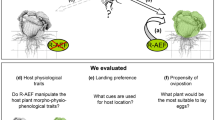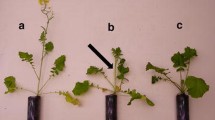Abstract
Broad bean plants (Vicia faba) infested by the pea aphid, Acyrthosiphon pisum, play a key role in the in-flight orientation of the parasitoid Aphidius ervi, by producing host-induced synomones (HIS). These volatiles are herbivore-specific and are systemically released from insect-free parts of an infested plant, suggesting the existence of an elicitor circulating throughout the plant. This study was designed to investigate whether the plant metabolic changes, leading to HIS biosynthesis and emission, can in some way trigger similar responses in neighboring plants through aerial and/or root communication. Uninfested broad bean plants maintained in the same pot together with plants infested by A. pisum became more attractive towards A. ervi females when tested in a wind-tunnel bioassay. This change was not observed when root contact was prevented among plants that had their aerial parts in close proximity, suggesting that an exudate from the roots of the infested plant may cause the induction of the attractive volatiles in uninfested plants. Broad bean plants grown hydroponically also produce pea aphid induced signals that attract A. ervi. When an intact (uninfested) plant was placed in a hydroponic solution previously used to grow a pea aphid-infested plant, it became attractive to parasitoids, while an intact plant placed in a solution previously used to grow an intact plant did not undergo such a change. These results indicate that plant-to-plant signaling in this tritrophic system may occur at the rhizosphere level and is most likely mediated by a systemically translocated elicitor.
Similar content being viewed by others
REFERENCES
Alborn, T. H., Turlings, T. C. J., Jones, T. H., Stenhagen, G., Loughrin, J. H., and Tumlinson, J. H. 1997. An elicitor of plant volatiles from beet armyworm oral secretion. Science 276:945–949.
Arimura, G., Ozawa, R., Nishioka, T., Boland, W., Koch, T., Kuhnemann, F., and Takabayashi, J. 2002. Herbivore-induced volatiles induce the emission of ethylene in neighbouring lima bean plants. Plant J. 29:87–98.
Birkett, M. A., Campbell, C. A. M., Chamberlain, K., Guerrieri, E., Hick, A. J., Martin, J. L., Matthes, M., Napier, J. A., Pettersson, J., Pickett, J. A., Poppy, G. M., Pow, E. M., Pye, B. J., Smart, L. E., Wadhams, G. H., Wadhams, L. J., and Woodcock, C. 2000. New roles for cis-jasmone as an insect semiochemical and in plant defence. Proc. Natl. Acad. Sci. USA 97:9329–9334.
Chamberlain, K., Guerrieri, E., Pennacchio, F., Petterson, J., Pickett, J. A., Poppy, G. M., Powell, W., Wadhams, L. J., and Woodcock, C. M. 2001. Induced plant signals, associated with aphids, transmitted aerially and through the rizosphere. Biochem. Syst. Ecol. 29:1063–1074.
Dicke, M. 1994. Local and systemic production of volatile herbivore-induced terpenoids: their role in plant-carnivore mutualism. J. Plant Physiol. 143:465–472.
Dicke, M. 1999. Evolution of induced indirect defence of plants, in R. Tollrian and C. D. Harvell, (eds.) The Ecology and Evolution of Inducible Defenses. pp. 62–88. Princeton University Press, Princeton, New Jersey.
Dicke, M. and Dijkman, H. 2001. Induction of indirect defence in undamaged plants by exposure to root exudate of herbivore-infested plants: potential for below-ground communication between plants. Biochem. Syst. Ecol. 29:1075–1087.
Dicke, M. and Van Loon, J. J. A. 2000. Multitrophic effects of herbivore-induced plant volatiles in an evolutionary context. Entomol. Exp. Appl. 97:237–249.
Dicke, M., Baarlen, P. Van, Wessel, R., and Dijkman, H. 1993. Herbivory induces systemic production of plant volatiles that attract predators of the herbivore: extraction of endogenous elicitor. J. Chem. Ecol.19:581–599.
Du, Y.-J., Poppy, G. M., and Powell, W. 1996. Relative importance of semiochemicals from first and second trophic level in host foraging behavior of Aphidius ervi. J. Chem. Ecol.22:1591–1606.
Du, Y.-J., Poppy, G. M., Powell, W., and Wadhams, L. J. 1997. Chemically mediated associative learning in the host foraging behaviour of the aphid parasitoid Aphidius ervi (Hymenoptera: Braconidae). J. Insect Behav. 10:509–522.
Du, Y.-J., Poppy, G. M., Powell, W., Pickett, J. A., Wadhams, L. J., and Woodcock, C. M. 1998. Identification of semiochemicals released during aphid feeding that attract parasitoid Aphidius ervi. J. Chem. Ecol. 24:1355–1368.
Guerrieri, E., Pennacchio, F., and Tremblay, E. 1993. Flight behaviour of the aphid parasitoid Aphidius ervi (Hymenoptera: Braconidae) in response to plant and host volatiles. Eur. J. Entomol. 90:415–421.
Guerrieri, E., Pennacchio, F., and Tremblay, E. 1997. Effect of adult experience on in-flight orientation to plant and plant-host complex volatiles in Aphidius ervi Haliday (Hymenoptera, Braconidae). Biol. Control 10:159–165.
Guerrieri, E., Poppy, G. M., Powell, W., Tremblay, E., and Pennacchio, F. 1999. Induction and systemic release of herbivore-induced plant volatiles mediating in-flight orientation of Aphidius ervi (Hymenoptera: Braconidae). J. Chem. Ecol. 25:1247–1261.
Mattiacci, L., Dicke, M., and Posthumus, M. A. 1995. Induction of parasitoid attracting synomone in Brussels sprouts plants by feeding of Pieris brassicae larvae: role of mechanical damage and herbivore elicitor. J. Chem. Ecol. 20:2229–2247.
Meijden, E. Van Der and Klinkhamer, P. G. L. 2000. Conflicting interests of plants and the natural enemies of herbivores. Oikos 89:202–208.
Miles, P. W. 1999. Aphid saliva. Biol. Rev. 74:41–85.
Miller, J. R. and Roelofs, W. L. 1978. Sustained-flight tunnel for measuring insect responses to wind-borne sex pheromones. J. Chem. Ecol. 4:187–198.
Moran, P. and Thompson, G.A. 2001. Molecular responses to aphid feeding in Arabidopsis in relation to plant defense. Plant Physiol. 125:1074–1085.
Ozawa, R., Arimura, G., Takabayashi, J., Shimoda, T., and Nishioka, T. 2000. Involvment of jasmonate-and salicylate-related signaling pathways for the production of specific herbivoreinduced volatiles in plants. Plant Cell Physiol. 41:391–398.
Pickett, J. A. and Poppy, G. M. 2001. Switching on plant genes by external chemical signals. Trends Plant Sci. 6:137–139.
Potting, R. P. J., Vet, L. E. M., and Dicke, M. 1995. Host microhabitat location by stem-borer parasitoid Cotesia flavipes: the role of herbivore volatiles and flocally and systemically induced plant volatiles. J. Chem. Ecol. 21:525–539.
Powell, W., Pennacchio, F., Poppy, G. M., and Tremblay, E. 1998. Strategies involved in the location of hosts by the parasitoid Aphidius ervi Haliday (Hymenoptera: Braconidae: Aphidiinae). Biol. Control11:104–112.
Rohlf, F. J. and Sokal, R. R. 1995. Statistical Tables, 3rd ed. W. H. Freeman and Company, New York, pp. 199.
RÖse, U. S. R., Manukian, A., Heath, R. R., and Tumlinson, J. H. 1996. Volatile semiochemicals released from undamaged cotton leaves–a systemic response of living plants to caterpillar damage. Plant Physiol. 111:487–495.
Sokal, R. R. and Rohlf, F. J. 1995. Biometry, 3rd ed., W. H. Freeman and Company, New York, pp. 880.
Takabayashi, J. and Dicke, M. 1996. Plant-carnivore mutualism through herbivore-induced carnivore attractants. Trends Plant Sci. 1:109–113.
Turlings, T. C. J. and Tumlinson, J. H. 1992. Systemic release of chemical signals by herbivoreinjured corn. Proc. Natl. Acad. Sci. USA 89:8399–8402.
Turlings, T. C. J., McCall, P. J., Alborn, H. T., and Tumlinson, J.H. 1993. An elicitor in caterpillar oral secretions that induces corn seedlings to emit chemical signals attractive to parasitic wasps. J. Chem. Ecol.19:411–425.
Turlings, T. C. J., Loughrin, J. H., McCall, P. J., RÖse, U. S. R., Lewis, W. J., and Tumlinson, J. H. 1995. How caterpillar-damaged plants protect themselves by attracting parasitic wasps. Proc. Natl. Acad. Sci. USA 92:4169–4174.
Vet, L. E. M. and Dicke, M. 1992. Ecology of infochemical use by natural enemies in a tritrophic context. Annu. Rev. Entomol. 37:141–172.
Vinson, S. B. 1985. The behaviour of parasitoids, pp. 417–469, in G. A. Kerkut and L. I. Gilbert, (eds.). Comprehensive Insect Physiology, Biochemistry, and Pharmacology, Vol. 9 Behaviour. Pergamon Press, New York.
Walling, L. L. 2000. The myriad plant responses to herbivores. J. Plant Growth Regul. 19:195–216.
Author information
Authors and Affiliations
Corresponding author
Rights and permissions
About this article
Cite this article
Guerrieri, E., Poppy, G.M., Powell, W. et al. Plant-to-Plant Communication Mediating In-Flight Orientation of Aphidius ervi . J Chem Ecol 28, 1703–1715 (2002). https://doi.org/10.1023/A:1020553531658
Issue Date:
DOI: https://doi.org/10.1023/A:1020553531658




